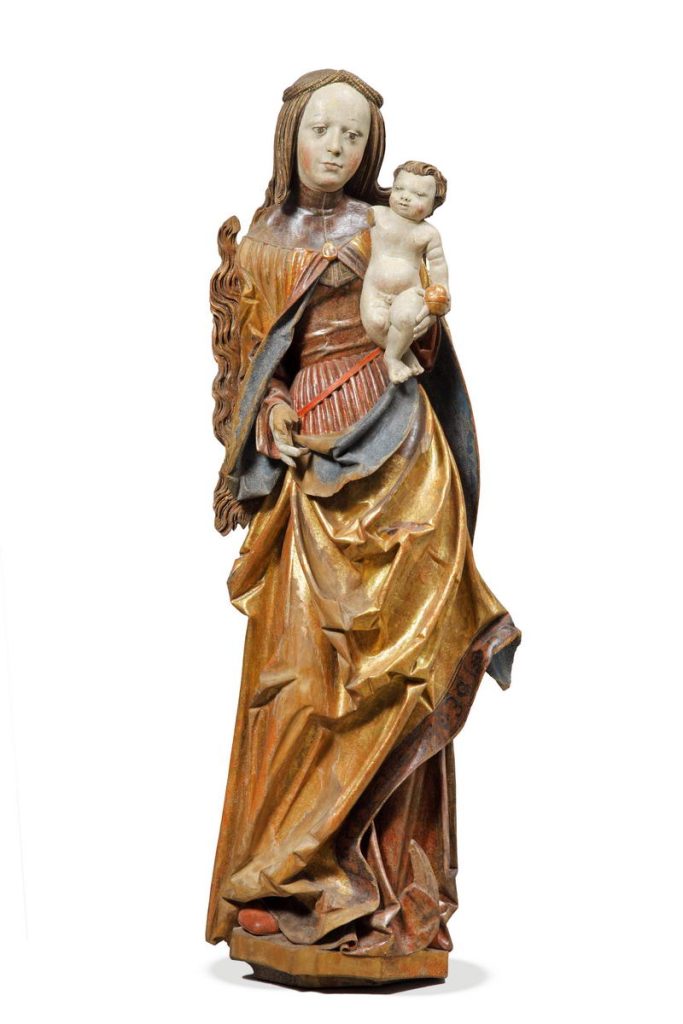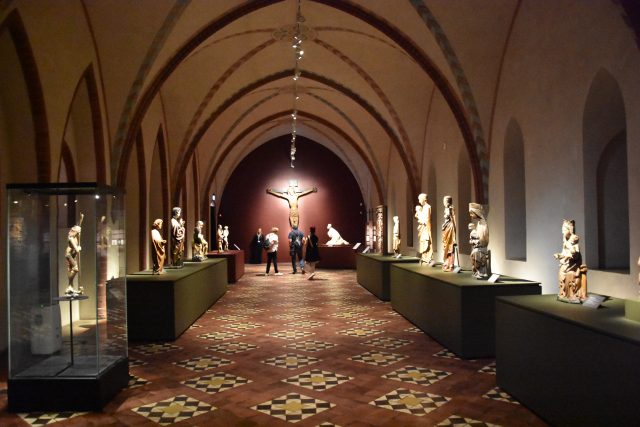News
‘Gothic sculpture from the collection of the Malbork Castle Museum’ – a new exhibition
A unique exhibition has been installed in the dormitories of the High Castle – ‘Gothic sculpture from the collection of the Malbork Castle Museum’. It is a presentation of exhibits from the Malbork sculpture collection, which craftsmanship sparks undeniable admiration for medieval woodcarving. From now on the unique atmosphere of the Gothic chambers of Malbork is highlighted by a number of figures of medieval saints and the beauty of Gothic sculpture. See you there!
The beginnings of the Malbork collection of Gothic sculpture date back to nearly the moment of the establishment of the Castle Museum in 1961. From the very beginning it was clear to museum curators that medieval artefacts, even those not directly related to the Monastic Prussia, would be an excellent illustration of the era in which the Order of the Blessed Virgin Mary grew, and that they would be a visual testimony to the piety, mentality and artistic explorations of the time. Over the sixty years of the Museum’s activity, exhibitions of sacred sculptures have been organised many times, on a smaller or larger scale and in various forms – from the Museum’s own collections as permanent galleries or from monuments loaned for temporary exhibitions. The number of exhibits gradually increased, either bought by the Museum or donated and deposited. Currently, although still relatively small, the sculpture collection includes a number of superb examples of medieval sculpture, primarily in the form of images of the Madonna and Child and various saints. The current exhibition features a selection of these. The exhibition is not arranged chronologically; the narrative is based on iconography, and creates a story about the cult of saints in the Middle Ages, seen from the perspective of the art of that period.

Art played a very important role in shaping religious attitudes and spreading cults in the Middle Ages. In the late Middle Ages, churches were filled with altars – large churches could have as many as several dozen. They were equipped with retables and liturgical vessels, and served both cult and didactic-moralising functions. Most of the believers could not read, and works of art were the ‘Bible for the poor’ (Biblia pauperum) – they conveyed the content of the Holy Scriptures and proclaimed the truths of faith through images. The cult of saints was a key feature of medieval Christianity. Saints played an important role in people’s everyday lives, and their martyrdom and miracles were widely known. Some cults, such as the veneration of the Blessed Virgin Mary or the Fourteen Holy Helpers, were widespread and were given special patronage in various matters. Others were local, strongly associated with specific cities, churches or pilgrimage centres. Individual social and professional groups also chose their patron saints to support their activities. This narrative was also reflected in Gothic sculpture.
Alongside depictions of saints, the exhibition presents examples of Gothic reliquaries. The term ‘relics’ comes from the Latin word reliquiae, meaning remains, heritage or memento. Christians used this word to describe everything that remained after the death of a saint. Initially relics were extracted from cemeteries and transferred to churches, and there they were placed in special recesses in altars called sepulchra. Later, they began to be displayed in public in decorative reliquaries resembling parts of the human body. This practice was sanctioned by the Fourth Council of the Lateran, which in 1215 decided that particles (i.e. fragments of relics) could only be venerated in protective casings. Particularly noteworthy is the reliquary associated with the cult of St. Ursula, which is a testimony to the religious and artistic contacts between the monastic state in Prussia and Western centres, in this case Cologne on the Rhine.
A significant theme addressed by the exhibition is passion piety. The cult of Christ’s martyrdom and resurrection deeply permeated medieval piety. Instead of contemplating the effects of Christ’s saving love, medieval Christians focused primarily on the figure of the Crucified God. The Passion theme came to the fore, combining with the motifs of penance, mortification and suffering in union with Christ. The cross or crucifix occupied a central place in medieval liturgy, and the Crucifixion was one of the most common motifs in the art of that period. The depiction of Jesus on the cross as dead, dripping with blood, frozen in suffering, was intended to arouse deep compassion and emotional involvement among the believers. At the same time, the cult of images of the Man of Sorrows (Vir Dolorum) developed. It was closely linked to mystical trends promoting passion piety and personal experience of Christ’s suffering, perceived as the result of human sins. The exhibition features a high-quality Gothic sculpture on this unique theme, which was added to the collection several years ago.

The undisputed highlight of the exhibition is a stone statue of Christ praying in the Garden of Gethsemane. It is one of the most important examples of European Gothic sculpture from around 1400. This work, created in a workshop in Prague, is distinguished by its high artistic quality. Its arrival in the Teutonic state in the Middle Ages testifies to the prestige and great importance of the sculpture, as it required considerable expense and physical effort. At the end of the 14th century, more statues made of the same material – marlstone (known as ‘golden opoka’) – were imported to Prussia from the Czech Republic. Most of them ended up in parish churches in Gdańsk and Toruń. These sculptures were intended for private worship, were small in size and sophisticated in form, and their emotional character allowed for close contact with the viewer. This can be clearly seen in the case of the Malbork statue: Christ looks at the viewer and his lips seem to speak. This creates an illusion of naturalism and interaction – the stone statue becomes a tool for individual religious practice.



Tickets
Buy tickets online
Opening Hours
- Mon:9:00 - 20:00
Exhibitions
- Tue - Sun:9:00 - 19:00
Contact
Tourist Information
- +48 55 647 08 00
- +48 55 647 09 02
- +48 55 647 09 78
